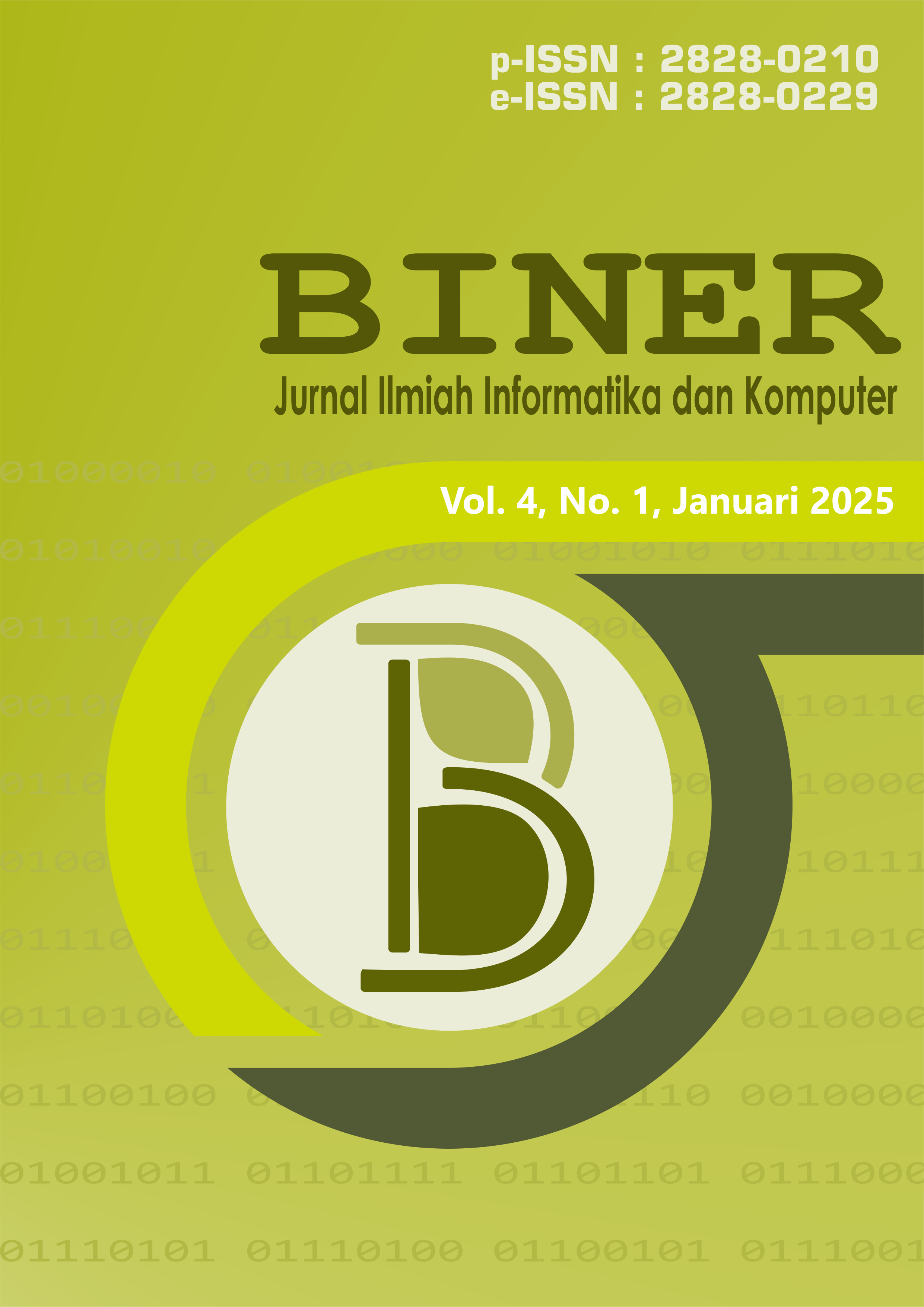PENERAPAN CLOUD COMPUTING DALAM MANAJEMEN PELANGGAN (CRM) UNTUK MENINGKATKAN LOYALITAS KONSUMEN
DOI:
https://doi.org/10.32699/biner.v4i1.8893Keywords:
Cloud computing, Manajemen bisnis, Customer Relationship Management.Abstract
Cloud computing telah muncul sebagai kekuatan transformasional yang mengubah wajah manajemen bisnis. Teknologi ini memungkinkan perusahaan untuk beralih dari infrastruktur IT tradisional menuju solusi yang lebih fleksibel dan skalabel, mendukung kebutuhan bisnis yang terus berkembang. Artikel ini mengkaji bagaimana cloud computing tidak hanya memfasilitasi penyimpanan dan pengelolaan data, tetapi juga mendorong efisiensi operasional, inovasi produk, dan peningkatan pengalaman pelanggan. Salah satu metode yang dapat diintegrasikan dengan cloud computing adalah Customer Relationship Management (CRM). Dengan memanfaatkan platform CRM berbasis cloud, perusahaan dapat mengelola interaksi dengan pelanggan secara lebih efektif. CRM membantu dalam mengumpulkan, menganalisis, dan memanfaatkan data pelanggan untuk memahami preferensi dan perilaku mereka. Dengan informasi ini, perusahaan dapat menawarkan produk dan layanan yang disesuaikan berdasarkan kebutuhan dan keinginan pelanggan, meningkatkan komunikasi dengan menggunakan data untuk berkomunikasi secara lebih tepat waktu dan relevan, serta memonitor loyalitas pelanggan dengan mengidentifikasi pelanggan setia dan mengembangkan program penghargaan yang menarik. Selain itu, CRM memungkinkan perusahaan untuk mengumpulkan dan menganalisis umpan balik pelanggan untuk melakukan perbaikan berkelanjutan pada produk dan layanan. Dengan memanfaatkan cloud computing dan metode CRM, organisasi dapat mengoptimalkan proses bisnis, menjawab tantangan pasar dengan cepat, dan menciptakan nilai tambah yang berkelanjutan. Pengintegrasian kedua teknologi ini tidak hanya meningkatkan efisiensi operasional tetapi juga memperkuat hubungan dengan pelanggan, yang pada gilirannya berkontribusi pada pertumbuhan dan keberlanjutan bisnis.
Downloads
References
[2] A. E. Febrianisa, I. Oktaviani, and W. Wijiyanto, “Sistem Informasi Monitoring Data Pesanan Customer Berbasis Website Pada JeeDee Advertising,” J. Comput. Sci. Inf. Syst. J-Cosys, vol. 4, no. 2, 2024, doi: 10.53514/jco.v4i2.521.
[3] I. Oktaviani and E. Purawanto, “ANALYSIS OF AI-BASED BIG DATA FOR STRATEGIC DECISION-MAKING IN E-COMMERCE,” pp. 266–278, 2024.
[4] J. Botlík and M. Janáková, “CRM as a tool to maintain the competitiveness of enterprises in the global digital economy,” SHS Web Conf., vol. 92, p. 05003, 2021, doi: 10.1051/shsconf/20219205003.
[5] E. Merzlyakova, I. Ershova, and E. Bridskiy, “Main Trends in the Development of the Global E-Commerce Market,” SHS Web Conf., vol. 110, p. 01035, 2021, doi: 10.1051/shsconf/202111001035.
[6] I. Oktaviani, B. Prajadi, U. Duta, and B. Surakarta, “E-Marketplace Pada Kelompok Ternak Kambing,” vol. 5, no. 1, pp. 138–143, 2023.
[7] I. Oktaviani, P. Widyaningsih, U. Duta, and B. Surakarta, “PENERAPAN CUSTOMER RELATIONSHIP MANAGEMENT PADA E-COMMERCE SEBAGAI UAPAYA PENINGKATAN LAYANAN,” vol. 6, no. 1, 2024.
[8] Zajačko I, Klačková I, and Kuric I, “Crm Systems-From Theory To Practice,” Int. Sci. J. “Innovations,” vol. 100, no. 3, pp. 97–100, 2019.
[9] A.A. Nimbalkar and B. A.T., “The Increasing Importance of AI Applications in E-Commerce,” Vidyabharati Int. Interdiscip. Res. J., vol. 13, no. 1, pp. 388–391, 2021.
[10] Y. Lee and P. R. J. Trim, “Enhancing Marketing Provision through Increased Online Safety That Imbues Consumer Confidence : Coupling AI and ML with the AIDA Model,” 2022.
[11] N. Ramane, N. Shitole, C. Landge, A. Konde, and A. Mote, “A Review on Different E-commerce Sites with Outfit Composition,” vol. 7, no. 3, pp. 143–145, 2019.
[12] E. Issues, “Developer Goals for e-Commerce Startups: Applying AI-enhanced Mind Genomics to Thinking about Everyday Issues,” Psychol. J. Res. Open, vol. 5, no. 5, 2023, doi: 10.31038/psyj.2023553.
[13] T. Änäkkälä, “Exploring value in eCommerce artificial intelligence and recommendation systems,” 2021, [Online]. Available: https://jyx.jyu.fi/handle/123456789/75678%0Ahttps://jyx.jyu.fi/bitstream/handle/123456789/75678/URN%3ANBN%3Afi%3Ajyu-202105172951.pdf?sequence=5.
Downloads
Published
Issue
Section
License

This work is licensed under a Creative Commons Attribution-ShareAlike 4.0 International License.
An author who publishes in this Journal agrees to the following terms:
- Author retains the copyright and grants the journal the right of first publication of the work simultaneously licensed under the Creative Commons Attribution-ShareAlike 4.0 License that allows others to share the work with an acknowledgement of the work's authorship and initial publication in this journal
- Author is able to enter into separate, additional contractual arrangements for the non-exclusive distribution of the journal's published version of the work (e.g., post it to an institutional repository or publish it in a book) with the acknowledgement of its initial publication in this journal.
- Author is permitted and encouraged to post his/her work online (e.g., in institutional repositories or on their website) prior to and during the submission process, as it can lead to productive exchanges, as well as earlier and greater citation of the published work (See The Effect of Open Access).















